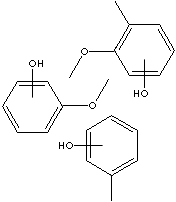| CAS
NO |
8021-39-4
|

|
| EINECS NO. |
232-419-1 |
| FORMULA |
|
| MOL
WT. |
|
|
H.S.
CODE
|
3807.00
|
|
TOXICITY
|
Oral
rat LD50: 300 mg/kg
|
| SYNONYMS |
Wood Creosote; Beechwood creosote; |
| SMILES |
|
|
CLASSIFICATION
|
DISINFECTANTS
/ |
|
PHYSICAL AND CHEMICAL PROPERTIES
|
| PHYSICAL
STATE |
Colorless to yellowish oily liquid |
| MELTING POINT |
-20 |
| BOILING
POINT |
200
- 240 C |
| SPECIFIC GRAVITY |
1.08 |
| SOLUBILITY
IN WATER |
0.1-1 g/100ml at 23 C
(But Soluble in methanol, acetone) |
| pH |
7
- 8 |
| VAPOR DENSITY |
|
|
REFRACTIVE
INDEX
|
|
|
NFPA
RATINGS
|
|
|
AUTOIGNITION
|
360
C
|
| FLASH
POINT |
|
| STABILITY |
Stable
under ordinary conditions |
|
GENERAL
DESCRIPTION & APPLICATIONS
|
|
Creosote refers to either of two products; coal tar creosote and wood tar
creosote. Coal tar creosote is a thick, amber to black oily liquid. Wood
creosote is a refractive to yellowish, oily liquid. Creosote products are
mixtures of many aromatic hydrocarbons including phenols and cresols. Creosote
obtained from coal tar is poisonous and provides protection against fungi,
shipworms, termites, and psoriasis. It is used chiefly as a wood preservative,
e.g., in wooden poles, railroad ties, and timber. They are also used as animal
and bird repellents. Animals may suffer skin irritation or ulceration from
creosote treated wood. Coal tar creosote and its derivatives are the most widely
used wood preservatives. Wood tar creosote is a mixture of chiefly guaiacol,
creosol and other phenolic compounds obtained from wood tar (mainly beech) by
distillation between 203 and 220 C. It is insoluble in water, soluble in
methanol, acetone. It is used as an external antiseptic, expectorant, gastric
sedative, deodorant, and as an antiseptic parasiticide veterinary use in the
form of creosote carbonate. It is used in the synthesis of pharmaceuticals and
vanillin. |
| SALES
SPECIFICATION |
|
BIBLIOGRAPHY
|
BP
/ JP
|
|
APPEARANCE
|
Colorless to yellowish oily liquid |
|
DISTILLATION
RANGE
|
200-230
C (BP, 95%) , 200-220 C (JP, 85%)
|
| TRANSPORTATION |
| PACKING |
30kgs
in plastic drum |
| HAZARD CLASS |
8
(Packing Group: II) |
| UN
NO. |
2922 |
| OTHER
INFORMATION |
|
Hazard Symbols: T, Risk Phrases: 24/25-34-52/53, Safety Phrases:
26-36/37/39-45-60 |
